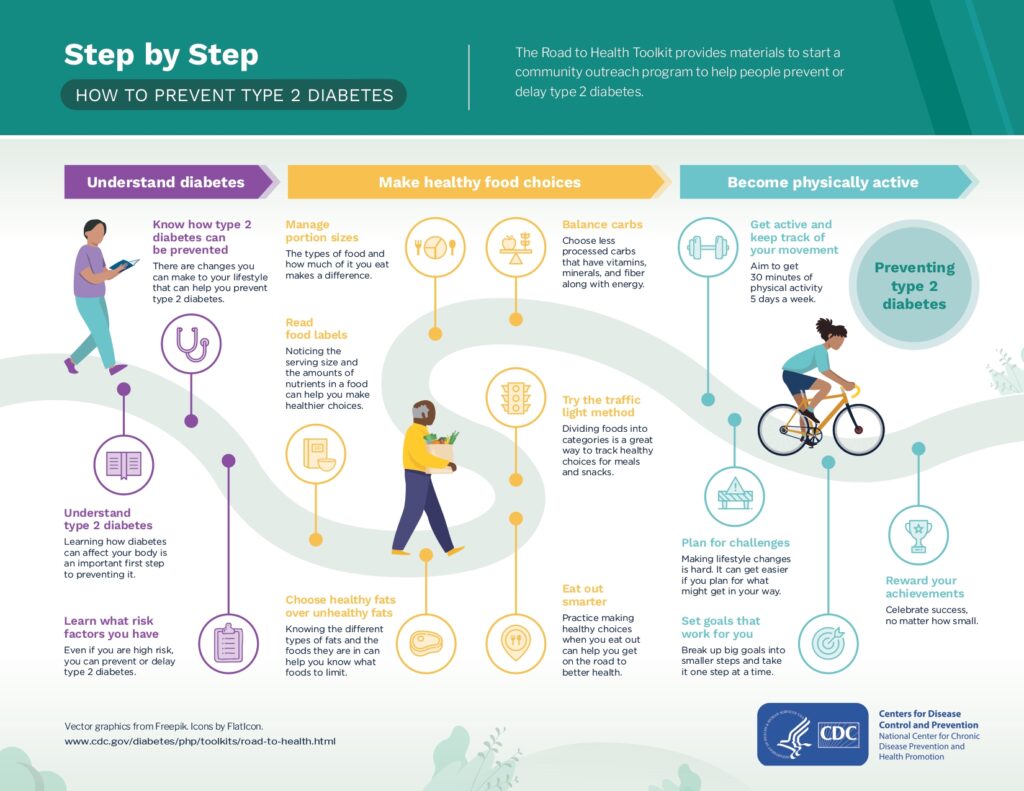Overview
Type 2 diabetes (or diabetes mellitus type 2) is a glucose metabolism disorder.
Glucose is the main fuel of all cells in our body. After absorption by the gastrointestinal tract, the level of glucose rises in the blood, and with the help of insulin (pancreatic hormone), it should get into every cell. When there is a deficiency of insulin synthesis or cells can’t respond to insulin, blood glucose levels stay beyond the normal range (hyperglycemia). Continuous hyperglycemia damages nearly every organ system.
There are two main types of diabetes: Type 1 and Type 2. In type 1 diabetes mellitus there is insufficient synthesis of insulin. Type 2 there the sensitivity of cells to insulin is decreased despite normal or even high blood insulin levels, and over time the synthesis of insulin also becomes low.
The etiology of type 2 diabetes is complex. The lifestyle (unhealthy diet, excessive calorie intake, obesity, sedentary lifestyle) and genetic factors are the main determinants of type 2 diabetes development. Having a first-degree relative (child or a sibling) with type 2 diabetes increases the risk of disease development 5-10 fold.
According to the CDC’s National Diabetes Statistics Report, the prevalence of diabetes in the adult US population is 14.7%. The prevalence rises with age. The data predicted that there would be a worldwide increase in the number of adults with diabetes from 537 million in 2021 to 786 million by 2045, a 46% rise.
Diagnosis
The diagnosis of type 2 diabetes mellitus is based on symptoms and laboratory testing.
The classic symptoms of type 2 diabetes mellitus are polyuria (frequent urination), polydipsia (excessive thirst), polyphagia (extreme hunger), and weight loss. Other symptoms of hyperglycemia are vision disturbances, lower extremity numbness or tingling, etc. Most patients remain asymptomatic over the years.
Blood glucose (sugar) level is the main diagnostic criterion for type 2 diabetes mellitus. Doctors use two types of blood glucose tests. A random blood glucose test measures blood glucose regardless of fasting time. A fasting glucose test is done after overnight fasting. The normal random blood glucose level is between 70 and 140 mg/dL (3.9 to 7.8 mmol/L). Whereas, the normal fasting glucose level is less than 100 mg/dL (5.6 mmol/L).
Treatment
The care of type 2 diabetes mellitus is provided with a multidisciplinary team of healthcare professionals, working in collaboration with a patient and a family. The main goal of treatment is to eliminate symptoms and prevent or slow the development of complications associated with type 2 diabetes mellitus.
Doctors set blood glucose goal, which vary from patient to patient. Dietary and exercise modifications are the foundation of diabetes management. Caloric restriction is of first importance; simple sugars, such as soft drinks and juices, and saturated fats should be restricted and replaced by healthy food. Weight loss with 5-10% significantly lowers the risk of complications.
Most patients can benefit from increased physical activity, not only by weight loss but, most importantly, by increasing sensitivity to insulin and lowering blood glucose levels. Patients should start physical activity slowly, especially those with a previous sedentary lifestyle. In certain conditions (atherosclerosis, coronary heart disease, hypertension), patients should start physical activity after cardiovascular evaluation.
Doctors also manage associated diseases, such as high blood cholesterol level and high blood pressure.
The risk of complications is elevated among smokers; therefore, smoking cessation is crucial for patients with type 2 diabetes mellitus.
Pharmacological treatment of disease is based on different medications that lower blood glucose levels. They improve the body’s response to insulin, promote insulin synthesis, promote glucose excretion in the urine, or reduce carbohydrate absorption from the intestines.
Self-monitoring of blood glucose is an important component of modern therapy for type 2 diabetes mellitus. Patients check blood glucose at home using a blood glucose meter. The results could help achieve a specific goal of blood glucose and prevent hypoglycemia (low blood sugar) during pharmacological therapy.
Complications and prognosis
Chronic complications are vision disturbances (diabetic retinopathy), heart attack and stroke, kidney damage (nephropathy), nerve damage (neuropathy), diabetic foot, vulnerability to infections, sexual problems, etc. Acute complications are hypoglycemia and hyperglycemia, diabetic ketoacidosis, and coma.
All above-mentioned complications shorten the life expectancy of patients with type 2 diabetes mellitus.
Prediabetes and type 2 diabetes mellitus prevention
The condition when blood glucose level is high, but it’s not high enough for diagnosing diabetes. Prediabetes increases the risk of diabetes development.
Changing a lifestyle could be a big step toward preventing diabetes. Healthy food, physical activity, and weight loss are mainstays of type 2 diabetes prevention.

Image source: www.cdc.gov






